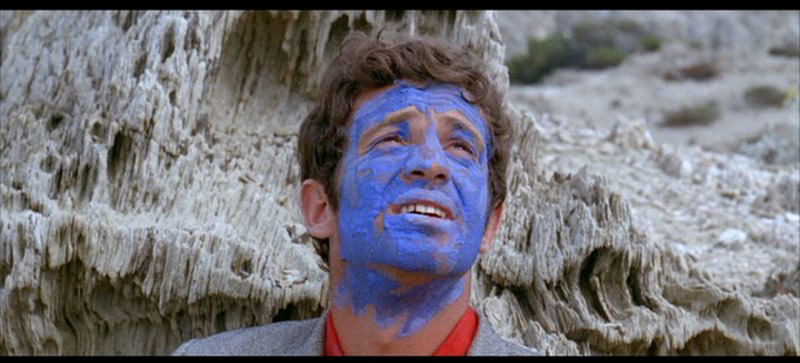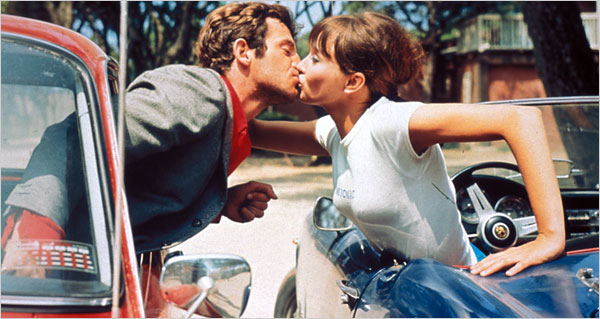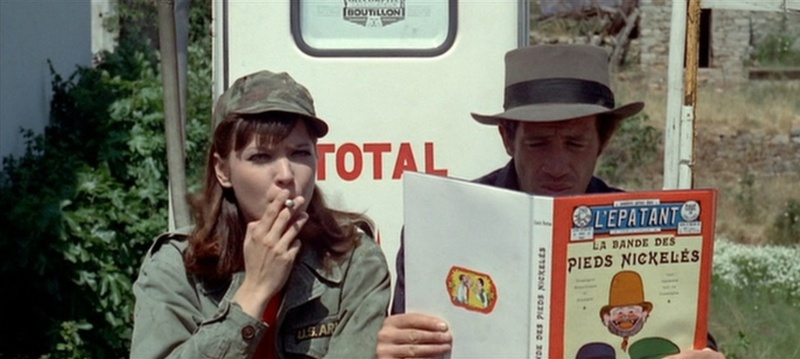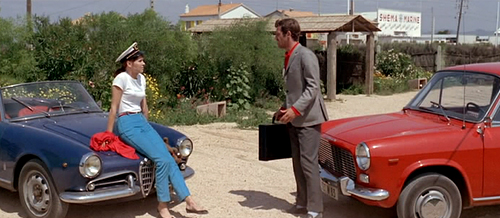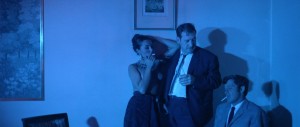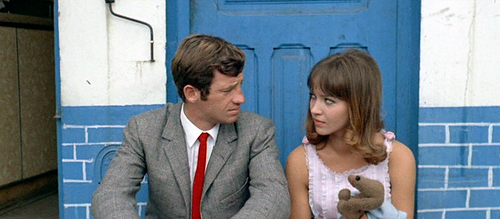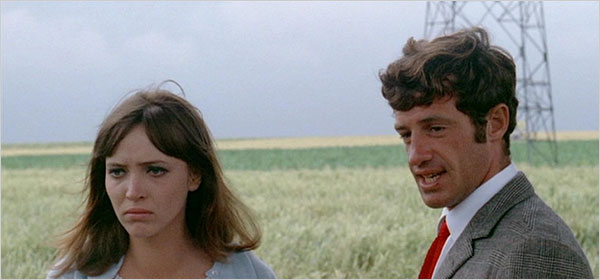From the June 9, 1989 Chicago Reader. –J.R.
PIERROT LE FOU
**** (Masterpiece)
Directed and written by Jean-Luc Godard
With Jean-Paul Belmondo, Anna Karina, Dirk Sanders, Raymond Devos, Graziella Galvani, Roger Dutoit, Hans Meyer, Jimmy Karoubi, and Samuel Fuller.
All the good movies have been made. — Peter Bogdanovich to Boris Karloff in Bogdanovich’s Targets (1968)
Two or three years ago I felt that everything had been done, that there was nothing left to do today. . . . Ivan the Terrible had been made, and Our Daily Bread. Make films about the people, they said; but The Crowd had already been made, so why remake it? I was, in a word, pessimistic. After Pierrot, I no longer feel this. Yes. One must film everything — talk about everything. Everything remains to be done. — Jean-Luc Godard in an interview about Pierrot le fou (1965)
After many years out of circulation, Jean-Luc Godard’s ninth feature is finally back, in a sparkling new 35-millimeter ‘Scope print, and the Film Center is celebrating with a week-long run. Looking at it again almost a quarter of a century after it was made, 20 years after its initial U.S. release, is a bit like visiting another planet; it’s an explosion of color, sound, music, passion, violence, and wit that illustrates what used to be regarded as cinema.
Regarding American cinema, at least, Bogdanovich’s remark of two decades ago has proved to be prophetic. If the contemporary Hollywood mainstream has any underlying credo, it’s that all the good movies have been made — which means that all anyone can do now is emulate, imitate, intensify, colorize, or make a sequel to the movies of the past. It’s a belief that is illustrated not only by the latest Indiana Jones epic and the summer of sequels we’ve got in store, but also by an anecdote related by Frank Brady in his recent biography of Orson Welles.
In 1982, Steven Spielberg spent $55,000 in an auction for a sled that was purported to be the original Rosebud sled from Citizen Kane; two years later Welles petitioned Spielberg to invest in an ambitious new project, The Cradle Will Rock, in which Spielberg’s wife, Amy Irving, had already been cast as the female lead. But even though Indiana Jones and the Temple of Doom was taking in almost $10 million a day at the time — and Welles’s entire projected budget was only half that amount — Spielberg wouldn’t invest a penny, or even pick up the tab for the lunch at which Welles made his pitch. The meaning of this episode? All the good movies have been made; it’s not so much a statement of fact in this case as a policy of expenditure that makes it a fact.
Godard’s statement that all remains to be done, on the other hand, carries an acute degree of historical pathos, if only because the movie that made him optimistic in 1965, Pierrot le fou, is even more unsuited to present tastes than Citizen Kane is. For all their differences, Godard and Welles share a certain aesthetic that guarantees that none of their best movies can be entirely consumed in a single viewing. Even after almost half a century of assimilation and popularizing that have contrived to make Citizen Kane “seem” like a Hollywood movie — a result of the ideological conditioning that was launched in part by Pauline Kael 18 years ago — the film continues to shock us by its obstinate refusal to behave like one.
Though Pierrot le fou was probably even more influenced by classic Hollywood than Citizen Kane was, it offers more of a rebuke to contemporary mainstream movies. To accept it at all, you have to be open to an attitude shared by such diverse works of the 60s as the Beatles’ Sgt. Pepper’s Lonely Hearts Club Band, Thomas Pynchon’s Gravity’s Rainbow, Jacques Tati’s Playtime, and Orson Welles’s Chimes at Midnight, which is that much more is going on here than you can possibly get a handle on. This doesn’t mean that the viewer is expected to work instead of play; on the contrary, the most striking thing Pierrot le fou shares with these works is its virtual nonstop playfulness. But the aesthetics of overload that it depends on has nothing to do with the simplified overkill of most contemporary movies. The sensory bombardment of Indiana Jones and the Last Crusade is predicated on the premise that nothing new is possible; the creative overload of Pierrot le fou –still as fresh as it was a quarter of a century ago — is predicated on the premise that everything remains to be done.
This overload begins with the opening credits, which consist of a single title card in which the letters spelling out the names of the two main stars and director and the film’s title gradually appear, in alphabetical order, in red and blue letters against a black background, creating a distracting puzzle. Then, as Jean-Paul Belmondo begins to read offscreen from Elie Faure’s History of Art (“Velasquez, after he reached the age of 50, no longer painted precise things . . .”), everything but the title in blue letters disappears, followed by all the letters but the two os, and then the final o in fou, which also disappears. It all might seem like arbitrary doodling, but in fact it’s a representation, in abstract and miniature terms, of the doom-laden romantic story that follows — a broad landscape that is progressively scaled down to two lonely souls, who eventually disappear as well.
The problem is we can barely take this all in, because as Belmondo continues to read from Faure offscreen — an obscure, untranslatable text that is very difficult to follow (“He hovered around objects with the air, with twilight, catching in his shadows and airy backgrounds the palpitations of color which formed the invisible core of his silent symphony”) — we see a pretty woman playing tennis. Then, as the text begins to grow still denser, there is a cut to Belmondo silently browsing at an outdoor paperback-book rack, where he selects the Faure book and enters the store to purchase it, then to an extended, lovely shot of a river at night, and finally to Ferdinand Griffon (Belmondo) in a bathtub, reading aloud from the book to his little girl.
The above sequence, credits included, lasts about three minutes — which means that we, and Ferdinand’s daughter, hear a great deal of Faure, at least until Ferdinand’s wife (Graziella Galvani) enters the frame and sensibly remarks, “You’re crazy to be reading her things like that.” Godard’s equally crazy in doing what he’s doing. But the sheer sensual pleasure of these three minutes — in the colors, compositions, framing, music, rhythm, and acting (Belmondo reads in his inimitable tough-guy manner, a cigarette dangling between his lips) — combined with the playful interactions between the text and images — proves that there’s plenty of method behind his madness. (The title refers to the heroine’s nickname for Ferdinand, and literally means “crazy Pierrot” — certainly not “Pierrot Goes Wild,” as the otherwise fairly serviceable subtitles have it.)
There’s even plenty of plot, as it turns out — a fairly rare occurrence in Godard’s filmography after Breathless. The film is based on a novel by Lionel White called Obsession, which is reportedly much closer to the movie than one might initially suppose. At the same time, the plot remains lucid only when it’s focused on the tortured romance at its center. Around the edges of this love story is an obscure thriller, which by design never achieves much clarity. It’s as if Godard were implying that in the contemporary world, intimate relationships, no matter how painful, are the only things that can make any sense.
Ferdinand, a jaded and recently fired Parisian TV executive, attends a party given by his wife’s father, who is supposed to help him get a job. Disgusted by most of the party guests, whose conversations literally consist of testimonials from TV commercials, Ferdinand leaves early. He drives the baby-sitter, a former lover named Marianne Renoir (Anna Karina), home and winds up spending the night with her. In the morning, he discovers a corpse in her apartment, and, after she brains a mysterious intruder with a wine bottle, they decide to take off for the south of France, supposedly to meet up with her gun-running brother. They become fugitives, alternately attempting to live idyllically by the sea and becoming involved with more violent murders through Marianne’s brother and his connections.
Godard reportedly made Pierrot le fou around the time that his own marriage to Anna Karina was beginning to fall apart, and the highly charged relationship between Ferdinand and Marianne and their conflicting natures — his reflective and intellectual, hers active and instinctual — registers as a candid view from the inside. The misogynistic aspect of this, a view of women as the ultimate betrayers, infused most of Godard’s work in the 60s, and, as Susan Sontag pointed out during that period, is difficult to disentangle from an equally characteristic romanticism about the couple. But Belmondo and Karina are so compelling in their own right that we aren’t always at the mercy of whatever Godard happens to think and feel about them.
According to Godard’s own account, the conception and execution of Pierrot le fou occurred almost simultaneously, without a prewritten script — using the art lingo of the period, Godard referred to it as a “controlled Happening” — and the movie’s shifting moods and rhythms appear to be a direct reflection of this improvisational construction. (“We’ve played Jules Verne long enough,” Marianne announces at one juncture by the beach; “let’s get back to our gangster movie.”) Four years earlier, Karina and Belmondo appeared in another Godard film, A Woman Is a Woman, which was inspired by musicals but perversely included no musical numbers; Pierrot le fou, whose sources are mainly Hollywood action and adventure films (as well as a few film noir touchstones like The Lady From Shanghai), features two delightful occasions when Karina breaks into song, with full off-screen musical accompaniment.
In the party sequence near the beginning, which evokes Frank Tashlin’s Will Success Spoil Rock Hunter? in its use of color filters and advertising patter, Ferdinand encounters the great American action director Samuel Fuller, playing himself. With the help of a translator Ferdinand asks Fuller, “What, exactly, is the cinema?” “A film is like a battleground,” Fuller replies, clutching a massive cigar. “It’s love, hate, action, violence, death. In one word, emotions.”
This is a fair enough description of Pierrot le fou itself, bearing in mind that the movie has as much in common with a Robert Rauschenberg painting as it has with a Fuller quickie. The overall collage method allows Godard to inject glimpses of paintings, convoluted flashbacks out of sequence, numerous literary quotations and references (from Rimbaud to Céline to Poe to Faulkner), a profusion of red and blue cars in the plot (most of them stolen) to tie in with his color scheme, countless fragmented looks at Ferdinand’s journal, several political allusions (including three sequences devoted to Vietnam), a real-life deposed princess from Lebanon who happened to be around during the shooting, and even a nightclub entertainer, Raymond Devos, who turns in a tragicomic musical routine at a crucial emotional and dramatic juncture.
The important thing about these nonlinear digressions is that they’re never completely arbitrary, even though the ways that we experience them are often disruptive. In a somewhat cubist manner, each offers a fresh slant on the film’s central premises. Two years after the film’s release, filmmaker and theorist Noël Burch, who subsequently did the film’s subtitles, wrote provocatively that “Godard has a very different view of the original subject from that of his audience, and he insists on revealing that subject from time to time precisely to remind the audience that he knows it more intimately than they do and has deliberately kept it hidden. On the level of communication, of course, this is tantamount to emphasizing the universal relevance of his story; but more significantly, this narrative method creates a dialectical tension between the subject and the discourse, fragments of the subject appearing and then disappearing in accordance with a rhythm that is quite essential to the discontinuous structure of the film.”
The major consequence of this discontinuity, which could be perceived as overload, is a liberation of the spectator. In contrast to the enslavement proposed by a fixed and continuous narrative, Godard offers a jagged yet seductive surface in which every apparent “interruption” is in fact a separate point of entry, another option for the viewer. In contrast with the Pavlovian invitation offered by Indiana Jones, which can only prompt a “yes” or “no” from the viewer — a thumbs up or a thumbs down, a pick or a pan — Pierrot le fou proposes an infinite variety of forms of engagement or disengagement, all of them guaranteed to give pleasure and keep us alert. And far from splintering our choices the way that Godard often divides his couple, between intellect and emotion, reflection and instinct, the movie as a whole gives us volatile mixtures — physical thoughts, sensual ideas, and thoughtful emotions.

